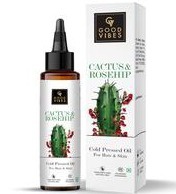
Highlights
Skim through
| Ingredient name | what-it-does | irr., com. | ID-Rating |
|---|---|---|---|
| Grape | |||
| Grape Seed Extract | antioxidant, antimicrobial/antibacterial | goodie | |
| Primrose | |||
| Primrose Oil | soothing, emollient | 2, 3 | goodie |
Good Vibes Roshehip Cold Pressed OilIngredients explained
This ingredient name is not according to the INCI-standard. :( What, why?!
We wholeheartedly support the rise of seedless grapes as fruit snacks, but when it comes to skincare, we are big fans of the seeds.
They contain the majority of the skin goodies that - similar to green tea - are mostly polyphenols (but not the same ones as in tea). The most abundant ones in grape are called proanthocyanidins, and 60-70% of them are found in the seeds (it's also often abbreviated as GSP - grape seed proanthocyanidins). In general, the darker the fruit, the more GSPs and other flavonoids it contains.
This ingredient name is not according to the INCI-standard. :( What, why?!
The oil coming from the seeds of the nice, little, yellow-flowered plant called Evening Primrose. Similar to other plant oils, it's loaded with nourishing and moisturizing fatty acids. It's a very rich source of linoleic acid (66-76%), and also contains the soothing and healing superstar fatty acid, gamma-linolenic acid (aka GLA, 7-12%) (Btw, the richest known source of GLA is the borage oil, but evening primrose still counts as a very good source of it). It also contains oleic acid, but not too much around 6-15%.
Since the 1980's, EPO is a well-known food supplement and there are quite a lot of studies examining what happens if you take it orally. It seems to be helpful with a bunch of things: atopic dermatitis, dry eyes, brittle nails, sunburn and even acne.
You may also want to take a look at...
| what‑it‑does | antioxidant | antimicrobial/antibacterial |
| what‑it‑does | soothing | emollient |
| irritancy, com. | 2, 3 |





